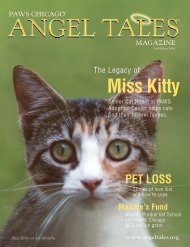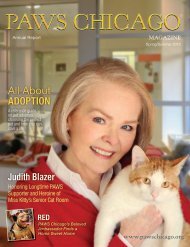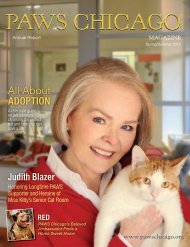Winter 2010 - PAWS Chicago
Winter 2010 - PAWS Chicago
Winter 2010 - PAWS Chicago
Create successful ePaper yourself
Turn your PDF publications into a flip-book with our unique Google optimized e-Paper software.
Transparency in Animal Sheltering continued<br />
> adoptable: is defined as any animal that is<br />
healthy or treatable – from illness or injury.<br />
Circling The Wagons Rather Than Changing<br />
With The Times<br />
Given the increasing and justified pressure from<br />
the public to reduce the killing, it should surprise no<br />
one that the traditional shelters go out of their way to<br />
hide the truth of their impounded animals’ outcomes.<br />
In addition to false oral representations by shelter personnel<br />
that the pet will be placed in a wonderful home,<br />
the illusion of saving lives is further carefully crafted<br />
with such representations as “there is no time limit for<br />
your pet’s stay in our shelter,” “we screen carefully to<br />
make sure your pet finds a loving home,” and “we exert<br />
our best efforts” to find the animal a home. These<br />
statements mask the true nature of the kill shelter’s<br />
operations, and that your pet may not find a home and<br />
instead will be euthanized.<br />
It’s What The Shelters Don’t Tell You That Can<br />
Cost Your Pet His or Her Life<br />
Many traditional shelters employ temperament<br />
tests. At best, these tests were designed to evaluate behavior<br />
so that issues can be remedied and to facilitate<br />
matching animals with appropriate homes. Yet far too<br />
often, temperament tests become an excuse to label<br />
animals “unadoptable” and summarily put them to<br />
death. For example, the SAFER test was created by<br />
Emily Weiss and is one of the most common temperament<br />
tests employed by shelters today. According to<br />
Emily Weiss’ website, the purpose of this test is to help,<br />
“animal welfare professionals all over the country<br />
identify potential aggression and opportunities for<br />
behavior modification – which ultimately leads to<br />
more adoptions through appropriate placement.” This<br />
test was not designed to snuff out the life of any animal.<br />
Other tests, such as the Sue Sternberg test which<br />
includes “food guarding” – taking food away from the<br />
shelter animal while he or she is eating to determine<br />
if the animal has any “aggressive” tendencies – have<br />
been subject to intense criticism and their validity,<br />
reliability and scientific basis, if any, have been called<br />
into serious question.<br />
Further issues of temperament testing reliability<br />
and validity include the fact that traditional shelters<br />
often employ these tests soon after the animal arrives<br />
at the facility when the animal is in unfamiliar and<br />
frightening surroundings, having recently been lost or<br />
abandoned. In addition, some shelters give temperament<br />
tests to animals too young for their personalities<br />
to have developed. Even if the tests were otherwise<br />
highly accurate in predicting behavior, under these<br />
conditions, the results can yield false positives for<br />
aggression.<br />
The most heinous aspect of temperament testing<br />
from a shelter transparency perspective is that many<br />
shelters use them to label animals “unadoptable” and<br />
euthanize them on that basis; then, they report to the<br />
public their adoption rate for “adoptable” animals<br />
only. This effectively excludes from reporting all of the<br />
> As the public increasingly demands better<br />
outcomes for shelter animals, some shelters<br />
work harder and implement improved<br />
programs to achieve better results for the<br />
animals. Other shelters, work even harder<br />
to conceal the truth.<br />
animals who were labeled “unadoptable” and killed.<br />
For example, a shelter may report that it saves “97% of<br />
adoptable animals,” without disclosing what happened<br />
to those labeled “unadoptable,” or what percentage<br />
were given the death label. This categorical exclusion<br />
from reporting for those labeled “unadoptable” deceptively<br />
solidifies the illusion of success and is a fraud on<br />
the public paid for with the lives of animals.<br />
Continued on page 34<br />
33
















